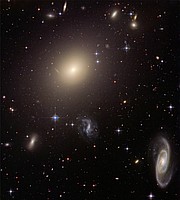Starry starry night
WASHINGTON - The universe may glitter with far more stars than even Carl Sagan imagined when he rhapsodized about billions upon billions.
A new study suggests there are a mind-blowing 300 sextillion of them, or three times as many as scientists previously calculated. That is a 3 followed by 23 zeros. Or 3 trillion times 100 billion.
The estimate, contained in a study published online Wednesday in the journal Nature, is based on findings that there are many more red dwarf stars - the most common star in the universe - than once thought.
But the research goes deeper than that. The study by Yale University astronomer Pieter van Dokkum and Harvard astrophysicist Charlie Conroy questions a key assumption that astronomers often use: that most galaxies have the same properties as our Milky Way. And that conclusion is deeply unsettling to astronomers who want a more orderly cosmos.
When scientists previously estimated the total number of stars, they assumed that all galaxies had the same ratio of dwarf stars as the Milky Way, which is spiral-shaped. Much of our understanding of the universe is based on observations made inside our own galaxy and then extrapolated to other galaxies.
But about one-third of the galaxies in the universe are elliptical, not spiral, and van Dokkum found they aren't really made up the same way as ours.
Using the Keck telescope in Hawaii, van Dokkum and a colleague gazed into eight distant, elliptical galaxies and looked at their hard-to-differentiate light signatures. The scientists calculated that elliptical galaxies have more red dwarf stars than predicted. A lot more.
"We're seeing 10 or 20 times more stars than we expected," van Dokkum said.
Generally scientists believe there are 100 billion to a trillion galaxies in the universe. And each galaxy - the Milky Way included - was thought to have 100 billion to a trillion stars. Sagan, the Cornell University scientist and best-selling author who was often impersonated by comedians as saying "billions and billions," usually said there were 100 billion galaxies, each with 100 billion stars.
Van Dokkum's work takes these numbers and adjusts them. That's because some of those galaxies - the elliptical ones, which account for about a third of all galaxies - have as many as 1 trillion to 10 trillion stars, not a measly 100 billion. When van Dokkum and Conroy crunched the incredibly big numbers, they found that it tripled the estimate of stars in the universe from 100 sextillion to 300 sextillion.
That's a huge number to grasp, even for astronomers who are used to dealing in light years and trillions, Conroy said.
"It's fun because it gets you thinking about these large numbers," Conroy said. Conroy looked up how many cells are in the average human body - 50 trillion or so - and multiplied that by the 6 billion people on Earth. And he came up with about 300 sextillion.
So the number of stars in the universe "is equal to all the cells in the humans on Earth - a kind of funny coincidence," Conroy said.
Slightly closer to home, at least in our own galaxy, another study also published in Nature looks at a single red dwarf star in a way that is a step forward in astronomers' search for life beyond Earth. A team led by a Harvard scientist was able to home in on the atmosphere of a planet circling that star, using the European Southern Observatory's Very Large Telescope in Chile.



